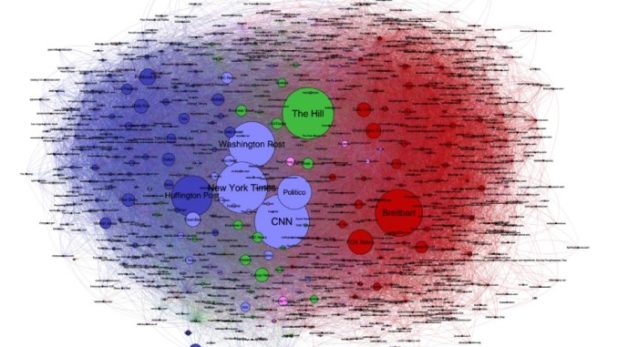Hunter Wallace
Occidental Dissent
March 5, 2017
This new study confirms what I have long suspected:
“THE 2016 PRESIDENTIAL ELECTION SHOOK the foundations of American politics. Media reports immediately looked for external disruption to explain the unanticipated victory—with theories ranging from Russian hacking to “fake news.”
We have a less exotic, but perhaps more disconcerting explanation: Our own study of over 1.25 million stories published online between April 1, 2015 and Election Day shows that a right-wing media network anchored around Breitbart developed as a distinct and insulated media system, using social media as a backbone to transmit a hyper-partisan perspective to the world. This pro-Trump media sphere appears to have not only successfully set the agenda for the conservative media sphere, but also strongly influenced the broader media agenda, in particular coverage of Hillary Clinton.
While concerns about political and media polarization online are longstanding, our study suggests that polarization was asymmetric. Pro-Clinton audiences were highly attentive to traditional media outlets, which continued to be the most prominent outlets across the public sphere, alongside more left-oriented online sites. But pro-Trump audiences paid the majority of their attention to polarized outlets that have developed recently, many of them only since the 2008 election season. …”
The prevalence of such material has created an environment in which the President can tell supporters about events in Sweden that never happened, or a presidential advisor can reference a non-existent “Bowling Green massacre.”
A remarkable feature of the right-wing media ecosystem is how new it is. Out of all the outlets favored by Trump followers, only the New York Post existed when Ronald Reagan was elected president in 1980. By the election of Bill Clinton in 1992, only the Washington Times, Rush Limbaugh, and arguably Sean Hannity had joined the fray. Alex Jones of Infowars started his first outlet on the radio in 1996. Fox News was not founded until 1996. Breitbart was founded in 2007, and most of the other major nodes in the right-wing media system were created even later. Outside the right-wing, the map reflects a mixture of high attention to traditional journalistic outlets and dispersed attention to new, online-only, and partisan media. …”
” … events in Sweden that never happened …”
It also sheds new light on why President Trump has been so emboldened to violate the reigning taboos and ban several Lügenpresse outlets from the White House.
President Trump’s supporters distrust the mainstream media. They are increasingly getting their information from a thriving rightwing media ecosystem which didn’t exist as recently as a decade ago. The backbone of the network has grown through social media.
In the last six years, the number of American households without a television has doubled. It is still a small number, but the story is in the demographics. The group that consumes the least amount of television are people younger than 25 years old. The group that consumes the most amount of television at home are those older than 75. More significantly, the households which do own televisions are consuming less programming as they turn to the internet for alternative sources of information.
Within the rightwing media ecosystem, Breitbart is displacing FOX News:
“This sidelining of Fox News in early 2016 coincided with sustained attacks against it by Breitbart. The top-20 stories in the right-wing media ecology during January included, for example, “Trump Campaign Manager Reveals Fox News Debate Chief Has Daughter Working for Rubio.” More generally, the five most-widely shared stories in which Breitbart refers to Fox are stories aimed to delegitimize Fox as the central arbiter of conservative news, tying it to immigration, terrorism and Muslims, and corruption …”
As we have seen, the average National Review subscriber is 66-years-old. The average FOX News primetime viewer is 68-years-old. This leads to two observations:
1.) First, the culture we inherited from the late 20th century with all its various taboos – the -isms and the phobias that Boomers were raised on – is a legacy of the left side of the media ecosystem on display above. The late 20th century is remarkable for being an unusual time of mass media consolidation. In the 1960s, we all used to get our news delivered to us vertically from a handful of elite newspapers, major magazines and television networks which had the power and legitimacy to police discourse. Newsweek, for example, used to be one of the most prestigious national news magazines. In 2010, it was sold for $1 dollar to Sidney Harman and it spent 2016 publishing breathless Kurt Eichenwald stories that no one in the rightwing media ecosystem trusted or bothered to read.
2.) Second, the rightwing media seems to have gone through three distinct phases. In the beginning, there was National Review which had power to police the boundaries of “respectability” on the Right largely because publishing and distribution was so much more expensive than it is today. In the 1990s and 2000s, FOX News and conservative talk radio established their dominance over the Right. In the 2010s, it is internet saavy sites like Breitbart and Infowars which are rising in the age of the smartphone and viral clickbait videos. It is striking how fast even minor blogs like Gateway Pundit and foreign tabloids like UK Daily Mail have risen to become key nodes in the network.
Observing all of this, I have to channel my inner Johann Tetzel (skip to 4:05): the smartphone and social media are your passport to the terrestrial joys of the ethnostate.
 Daily Stormer The Most Censored Publication in History
Daily Stormer The Most Censored Publication in History



